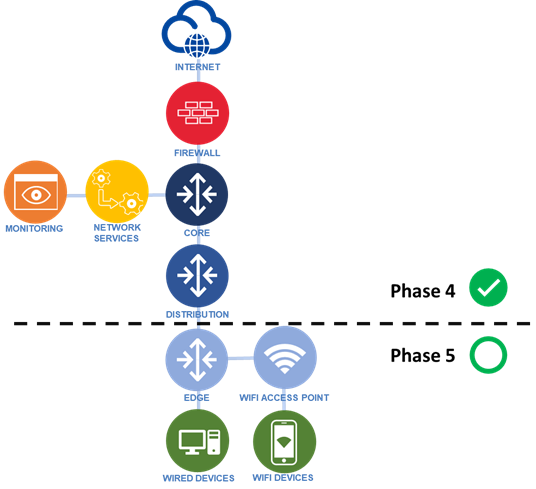
Phase 1-3
The NP is a complete refresh of our network infrastructure which orchestrates the flow of data to and from over 38,000 connected devices every day. The NP commenced in 2021 and a huge amount has already been achieved across the first four phases of work.
A brief history of the Network Programme (NP)
The Network Programme (NP) represents a comprehensive renewal of our campus-wide network infrastructure, facilitating the daily flow of data to and from approximately 38,000 connected devices. Launched in 2021, the NP has already delivered significant progress across its initial four phases:
- Phases 1 & 2: Programme initiation, high-level solution designs, and business case development.
- Phase 3: Governance approvals and competitive procurement of an implementation partner and technology vendor.
- Phase 4: Replacement of the centralised core infrastructure underpinning the network, alongside extensive surveying activities and pilot upgrades for select buildings.
The programme is now poised to commence the roll-out of the new network across all campus buildings. This work constitutes the remaining phases of the NP and is expected to span the next 3.5 years. Following completion, the network will transition into a regular upgrade cycle to ensure it remains fit for purpose in the future.
Why was the NP necessary and what are the benefits?
Data is one of the greatest assets of a research based university and the ability to collect, transmit, store, process and access that data is fundamental. Network infrastructure can therefore be regarded as an essential 4th utility in every building, akin to power, heating and plumbing. There are two main drivers that necessitated the NP:
Firstly, demands on the network are ever increasing with higher and higher data volumes needing to be collected, stored and analysed. Our students, researchers and staff need to access data, applications and digital services wherever they choose to work via fast and robust Wi-Fi. The NP will ensure that these demands are met, for example by significantly enhancing Wi-Fi coverage and speeds.
Secondly, the vast majority of the existing network infrastructure is end-of-life. This is a perilous state to be in with an increasing risk of partial or complete network failure with the associated wide impacts that would result across a number of University activities; in April 2024, a failure in an aged network component disrupted exams. An additional risk arises from cyber-threats due to vulnerabilities that cannot be fixed if the vendor has ended support; our current network is supplied by Cisco who suffered 26 security vulnerabilities rated high or critical the first quarter of 2024 alone. Out-of-support infrastructure cannot be updated to fix such vulnerabilities and therefore these pose a security threat to the University. The NP will ensure that all end-of-life infrastructure is remediated, improve the resilience of the network and upon completion smoothly transition to an ongoing annual cycle of replacement to ensure this state is maintained in the future.
Goals
The Goals of the Network Infrastructure Investment Programme are as follows:
- Build a network suitable for delivering ‘non-stop’ services and build a modern network that is fit to support future business needs
- Build an ongoing programme that ensures the network is always fit for purpose
- Ensure the UofG has high capacity, low latency connectivity across the campuses that enables digital services and supports the user experience, including but not limited to, research applications, teaching and learning, guests and visitors, Wi-Fi, 5G, BLE etc.
The anatomy of a data network
Data networking is a deep specialism within IT, and this business case assumes no such knowledge! However, a brief explanation of how our data network works is helpful to understand what has been done so far, and what remains.
|
Figure 1 – Anatomy of a campus data network |
|
Glossary
Information Services (IS): Combines the Library and IT Services and focuses on the implementation of a coherent information strategy, the provision of user-centric services for students and staff, the provision of first-class learning spaces and the optimal use of enterprise systems and technology as a whole
Janet: Janet is a high-speed network for the UK research and education community provided by Jisc, a not-for-profit company set up to provide computing support for education.
Network Design Authority (NDA): The creation of an NDA role is a high priority goal of the NP TOM. These will be among the duties of the NDA, for which a Terms of Reference shall be developed in full for approval:
Documentation and diagrams for the campus network are to be created and managed. Architecture is to be planned according to industry best practices
Areas that require improvement are to be identified based on network monitoring, hardware capabilities, and architecture requirements, as well as future planning initiatives
The role will also drive and set the example for network standards and their guidelines
Network Infrastructure Investment Programme (NP): The UofG’s ambitions are to design and build a forward-thinking, future proof network infrastructure to underpin current and future business needs. The Network Infrastructure Investment Programme will invest now to modernise the network as well as sustain investment on an ongoing basis to ensure that the UofG’s network continues to meet the needs and ambitions of its users (i.e., its students, staff, visitors (incl. suppliers and guests) and remote users of digital services).
NP Team: The NP team is comprised of the NP Change Manager (Jon Mosca), Junior NP Project Manager (Numaan Khan), and two Helpdesk Analysts (Andy Bell and Christopher Atkinson) and they are responsible for ensuring the NP TOM addresses all operational needs on the campus network.
Primary Technology Partner (PTP): UofG have onboarded a Primary Technology Partner (PTP), Capita IT Services, who is going to be key in the deployment of the NP and the TOM. The PTP will be our primary contact for the procurement, configuration, and deployment of hardware, and for all technical support required for said hardware. They will also be responsible for ensuring the continued support for the networking assets procured and deployed for the NP.
RAIDs: RAID analysis is a project planning technique for identifying key project Risks (R), Assumptions (A), Issues (I), and Dependencies (D). Project teams should complete an initial analysis at the beginning of the project and then monitor the issues via a RAID Log. Each item can be rated based on its impact on the speed, profitability, or outcomes of the project, allowing you to focus on what is most important.
RACI: Responsible, Accountable, Consulted, Informed. A responsibility assignment matrix, also known as RACI matrix or linear responsibility chart, describes the participation by various roles in completing tasks or deliverables for a project or business process.


